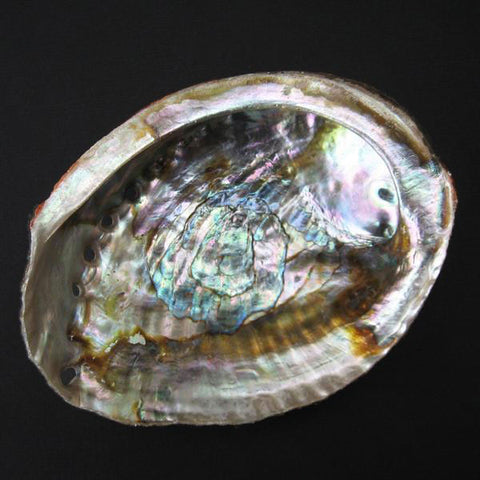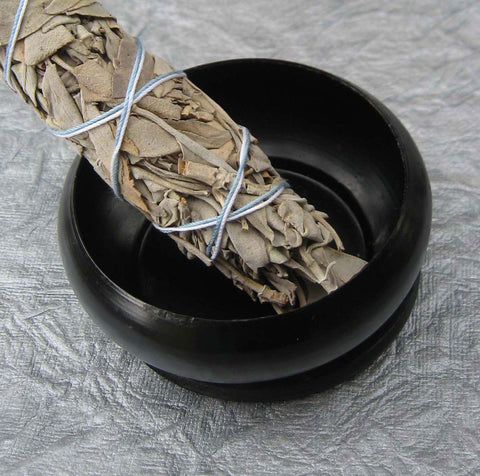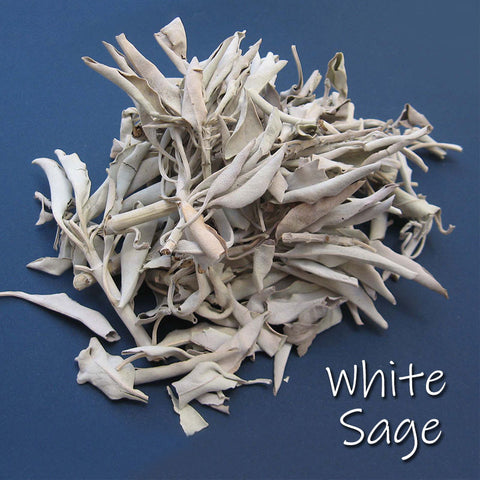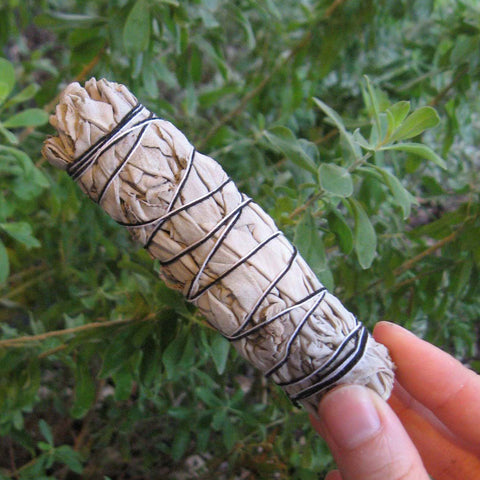
Freshen up your life with the cleansing power of herbal incense! Smudging questions are some of the most common ones we get around the shop, so I’ve put them together in little bundle (heh). We cover why and when to smudge, some popular smudging herbs, and other questions people ask about smudging and space cleansing. Skip to the bottom of this article for a sample smudging ritual that is easy to do and suitable for most situations.
What is smudging?

Smudging is the practice of spiritual cleansing with smoke, especially from sacred herbs. You can smudge a person, a place, a building, or an object. “Smudge” is both a noun and a verb—a bundle of herbs burned as incense is also called a smudge.
The term derives from the Middle English word smogen, from which we also get the words smoke, smog, and besmirch. (Those who lived in smoky medieval cottages might be puzzled that we now use smoke to purify our homes, but hey—history marches on.)
Why smudge?
Smudging is done to remove bad energy and bring a feeling of peace and clarity. Most people can tell when a place just doesn’t “feel” right. Smudging is a remedy for that. Smudging uses the natural qualities of aromatic plants, along with the smudger’s prayers and intentions, to improve the psychic environment.
Smudging is a basic ritual, but it can be a very effective one. It is an act of will that removes negative influences and sets a positive intention for your home, tools, or workplace.
Some people also use smudging as a first step in setting sacred space. Smudging is a way to invite higher spiritual vibrations into a place of healing or meditation.
What tools do I need to smudge?
The only thing you really need for a smudging ritual is your choice of natural incense or herbs. You’ll also need a source of fire—matches, lighter, or flint (for purists). Other than that, the most important tools you can bring are a clear mind and an open heart.
There are all kinds of other accessories that can become a part of your smudging practice. (Links go to our store, and your purchases help support this site.)

Abalone shells are a traditional vessel for catching the ashes from smudging. They come in various sizes. (Abalone shells should not be exposed to direct heat, as they can scorch.)

Smudge pots are made of stone, ceramic, or metal. Unlike shells, they can be used to hold burning smudges. Smudge pots are very useful when burning loose herbs or individual leaves.
Wooden stands may be used to hold the shell or smudge pot steady. Stands elevate the smudging vessel and prevent heat from transferring to your altar or tabletop surfaces.
Incense charcoal is used for burning loose or herbal incense. While not always necessary, it can be useful to have it on hand in case your smudging herbs don’t want to stay lit.
A dish of sand helps absorb the heat from smudges and/or charcoal. You can use colored ritual sand, plain sand, or even dirt from the earth. A layer of sand is also excellent for putting out a smudge when you are finished with the ritual. (Water is not traditionally used to extinguish smudges. However, it is a good fire safety practice to have water or a fire extinguisher nearby anytime you are working with open flame.)

Smudging feathers and smudging fans are used to direct the smoke where you want it to go. They represent the element of Air and the circulation of energy through the world. (Their use is optional.)
Smudging prayers and posters contain pre-written words for directing your smudging ritual. Voicing the words aloud causes your intentions to resonate more strongly. The level of spontaneity is up to you. If you don’t want to compose or memorize your own smudging prayer, it’s perfectly okay to use a cheat sheet.
What are some common smudging herbs?
Theoretically, you can smudge with any fragrant smoke, including conventional incense. But there are certain plants that have a reputation for raising the vibration of your space. Each of these plants has a different energy and aroma to contribute to your smudging rituals.

When most people think of smudging, they think of White Sage. White Sage is a shrub that grows in the American Southwest. It has a fresh herbal fragrance and benevolent cleansing energy. White Sage is part of an extended family of sages, including Blue Sage and Mountain Sage.

Sweetgrass is a long prairie grass with a calming, Vanilla-like aroma. It is burned in small quantities to perfume and purify the environment.

Palo Santo is a small, slow-growing tree that is distantly related to Frankincense trees. Palo Santo wood is a rare and expensive incense with a spicy, complex fragrance. It is native to South America.

Many evergreen trees have dry, resinous leaves that may be used for smudging. Cedar, Juniper, and various Pines are especially favored by Witches of the mountains and forests.
We have a comprehensive article about the various smudging herbs. Find out more here.

Where do I get smudging herbs and tools?
You can get smudging herbs from most spiritual supply shops and even health food stores. Other smudging tools can be purchased or improvised from household items. (Do reserve them for sacred use, though, once that function has been assigned.)
Some people like to grow or gather their own smudging herbs. If you live in a climate where this is practical, it’s a wonderful way to connect with the plant spirits.

How often should I smudge my home?
Most people smudge on an as-needed basis. These are the most common occasions for performing a smudging ritual:
- When moving into a new space. You wouldn’t wear used clothes without first washing them, and some people won’t move into a new home or office without smudging. Smudging helps clean up the psychic debris from previous occupants, so their energy won’t influence your thoughts and emotions. (If you’re a real sweetheart, you can also smudge when moving out to make the space welcoming for the next resident.)
- When there has been a psychic disturbance. Some events will leave their mark on a space in the form of yucky energy. They can be major disturbances (such as hauntings or acts of violence), or minor disturbances, such as when people in the house have been quarreling).
- To mark an important positive change. Smudging is a way of hitting the reset button on a home’s energy, so it makes sense to do it when you’re ready for a fresh start. For example: When you’ve finished seasonal housecleaning, when a toxic person moves out, or when you’re celebrating breaking a habit or addiction.
- When it’s that time again. Some people do smudging at regular intervals, as a kind of scheduled spiritual hygiene. Regular smudging keeps your home’s vibe fresh and stops anything negative from taking hold. Like clutter, the buildup of stale energy may not become noticeable because it’s so gradual.
Annually, monthly, weekly? It all depends on your needs. You may wish to use magickal timing or personally significant dates for your smudging regimen. You can schedule smudging rituals for the New Moon, New Year, your birthday, solstices or equinoxes, or other important anniversaries.
Do you need to be religious to smudge?
Smudging is associated with various Pagan, shamanic, and New Age ideas. However, the practice itself does not require any specific religious beliefs. Smudging, like all magick, is based on intention. All you really need to believe is that you can cleanse yourself, your space, and your possessions. Even skeptics and atheists have told me they see benefits from performing self-cleansing rituals.
Many spiritual paths use incense to help draw one’s thoughts to the Divine. Most also hold in common the benefits of prayers, blessings, and acts of hospitality. I don’t see a conflict between smudging practices and any world religions. However, if you have concerns, you can always speak with a leader within your faith.

I’ve heard that smudging shouldn’t be done by people who aren’t Native American. What’s up with that?
Some of the best-known smudging tools—White Sage, Abalone shells, Sweetgrass and bird feathers—were first used in the spiritual practices of natives of the American Plains and Southwest. Some people feel that you need to be initiated in one of these traditions to use these tools. Other people believe that because native peoples were systematically oppressed by whites, it’s not in good taste for white people to work with these objects.
Cultural appropriation is a complex topic, and one that always stirs up strong feelings. These are issues that should be (and are being) hashed out in our various spiritual communities through respectful dialogue.
My two cents? I’ve found that the smudging debate gets routinely re-ignited by well-meaning but easily offended people. These people—while they may have some justification for their concerns—are often driven by a desire to control and limit others people.
Nobody “owns” the energies of certain plants. They are gifts of the Earth, and they confer their blessings (usually) without regard for ancestry. While they’re often willing to cooperate with human magick workers, they’re not that interested in human concepts of ownership and racial division. These beings were here before us, and they’ll likely be here long after us.
However, it is important to be respectful and humble, especially when sharing ritual space with others. It is rude and ridiculous to borrow willy-nilly from every tradition you encounter.
If you don’t feel it’s right to use herbs and tools from other cultures, you need not miss out completely. Spiritual use of herbs and incense is common to most world traditions and there are plenty of plants to choose from.
Some European-tradition Witches smudge with green Sage or Rosemary—both Old World plants associated with wisdom and healing. Try reaching out to ancestors or spiritual guides (or to the plant spirits themselves), and you will be able to learn what herbs are most appropriate for your own practice.
Is it true that you shouldn’t blow out smudge sticks?
At least once a month, someone tells me that candles and/or smudge sticks should never be blown out with the breath. This is one of those witchy superstitions that never seems to die. Like most magickal “don’ts,” I think it’s mostly silliness with a grain of truth.
Blowing a smudge out with air could cause sparks to fly around, and there’s always a chance that the smudge could still be smoldering inside. It’s better to tamp it out in a dish of sand or on cleared ground, and then leave it in a heatproof container just in case.
Water is said to cancel out the cleansing power of Fire, and is never used to extinguish magickal incenses. But there’s a practical reason for that, too—soggy smudges can attract mildew.
I’m sensitive to smoke and/or allergic to Sage. How do I smudge?
Not everyone experiences Sage smoke as a gentle, healing breeze. Some people collapse into coughing and watery eyes whenever the stuff is around. Smudging can also set off smoke detectors and (Goddess forbid) fire sprinklers in small homes and offices.
Fortunately, there are alternatives. Sage, Sweetgrass, and Palo Santo are widely available as scented oils and water-based sprays, for those times when smoke is not practical or welcome.
You can also cleanse your space with light, water, crystals, sound (voice or bells), or visualization. These smoke-free methods are not technically smudging, but they can be just as effective when combined with your focused intention. For those who host public workshops and gatherings, it’s smart to have a few smudging alternatives in your toolkit. That way, you can be prepared to accommodate allergic and scent-averse ritual participants.
Keep in mind that closely related plants may still affect you differently. For example, I’m fine when someone’s burning White Sage, but a close cousin, Blue Sage, makes me itch and sneeze like crazy. It may take some trial and error to find your go-to smudging partner.

I’m new to smudging. How to I begin?
Here’s a simple, effective smudging ritual that even a first-timer can do. It doesn’t require any special tools, and it’s easy to adapt to your needs and spiritual beliefs:
A simple smudging ritual for houses and apartments
The keys to a successful house cleansing are intention (knowing strongly what you want) and visualization (being able to "see" your actions being effective).
First, clean your house. Sweep the floors, throw out the garbage, and just tidy your belongings as best you can. Physical clutter and dirt can trap stagnant energy, and make it harder to feel the effects of your efforts.
Choose a smudging herb that you like—one whose energy and aroma is agreeable to you. Hold it between your palms and thank it for lending its energy to your rite.
As you light the smudge stick, say a prayer that your home is a place of love, peace, and harmony. Ask that all who live there and enter as guests be blessed and protected.
Before you begin smudging the house, you may want to smudge yourself first. Wave the smoke around your body, starting at your head and working down to your feet. Visualize any fear, anger, or worry you carry in your body blowing away into the air or traveling down into the ground, to be absorbed and cleansed by the earth. (Some people "see" or visualize negative energy as dark, cloudy energy.) Take a deep breath and replace it with clean fresh air and white light. Allow the white light to flow down from your lungs and heart, joining the clean smoke in your hand.
Now you're ready to cleanse the home, room by room. (I usually do a full circle of my house, starting and ending at the front door.) Let the smoke float into every hallway and corner. As you walk from place to place, see the old, unwanted energy dissolving and floating away. You can speak your intention aloud, or just use a silent prayer or visualization. If any areas feel particularly thick or heavy with bad energy, spend some extra time there.
When you've returned to where you started, extinguish the smudge by rubbing it out in a dish of sand. Affirm that your work is done, such as by clapping your hands and saying, “So it is!” Then sit for a moment and savor the difference in how the energy feels.
Smudging isn't permanent and will need to be repeated eventually. I smudge my house usually twice a year, but once a month is better.
Thank you for reading! Happy smudging, and may you (and your home) be blessed.
Read more articles in the archive.
Disclaimer: Nothing on this website should be taken as medical, financial, or legal advice. All herbs are intended for external adult use only. Some herbs may not be suitable for all persons—consult a licensed professional if you have concerns. Incense, candles, and herbs can cause fire hazards. Please observe proper safety precautions when using these products.

